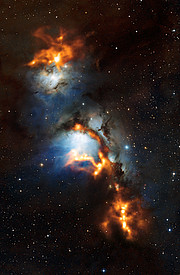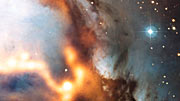Persbericht
Het stof in de Orion-gordel uitgeplozen
2 mei 2012
Een nieuwe opname van het gebied rond de reflectienevel Messier 78, even ten noorden van de gordel van Orion, laat zien dat de nevel doorregen is met een ‘parelketting’ van kosmische stofwolken. Bij de waarnemingen, gedaan met de Atacama Pathfinder Experiment (APEX)-telescoop [1], is gebruik gemaakt van de warmtegloed van de interstellaire stofdeeltjes, die astronomen laat zien waar nieuwe sterren worden gevormd.
Stof lijkt saai en oninteressant – een laagje vuil dat de schoonheid van een object aantast. Maar deze nieuwe opname van Messier 78 en omgeving, die de submillimeter-straling van stofdeeltjes in de ruimte toont, laat zien dat stof oogverblindend mooi kan zijn. Stof is van belang voor astronomen, omdat dichte wolken van gas en stof de kraamkamers van nieuwe sterren zijn.
In het midden van de foto staat Messier 78, ook bekend als NGC 2068. In zichtbaar licht waargenomen vertoont dit gebied zich als een reflectienevel, wat betekent dat we de bleke blauwe gloed zien van sterlicht dat door stofwolken wordt weerkaatst. De APEX-waarnemingen (oranje gekleurd) zijn hier over zo’n opname in zichtbaar licht heen gelegd. Gevoelig voor langere golflengten, tonen zij de zachte gloed van dichte, koude opeenhopingen van stof, waarvan sommige nog kouder zijn dan -250 °C. In zichtbaar licht is dit stof donker en verhullend, wat precies de reden is waarom telescopen zoals APEX zo belangrijk zijn voor het onderzoek van stofwolken waarin sterren worden geboren.
Een van de filamenten die met APEX zijn waargenomen, vertoont zich in zichtbaar licht als een donkere stofband die Messier 78 doorsnijdt. Dat betekent dat het dichte stof zich vóór de reflectienevel bevindt en het blauwachtige licht ervan tegenhoudt. Een ander opvallend gebied van gloeiend stof dat met APEX is vastgelegd, overlapt het zichtbare licht van het onderste deel van Messier 78. Het ontbreken van een donkere stofbaan op opnamen in zichtbaar licht vertelt ons dat dit stofrijke gebied achter de reflectienevel moet liggen.
Waarnemingen van het gas in deze wolken laten zien dat uit sommige van de stofconcentraties met hoge snelheid gas wegstroomt. Deze gasstromen worden uitgestoten door jonge sterren-in-wording. Hun bestaat bevestigt dus dat in deze stofwolken actieve stellaire kraamkamers zijn.
Bovenaan de foto is nog een andere reflectienevel te zien: NGC 2071. Waar de gebieden onderaan de foto alleen lichte jonge sterren bevatten, herbergt NGC 2071 een groter exemplaar dat naar schatting vijf keer zo zwaar is als de zon – de heldere kern in de APEX-gegevens.
De APEX-waarnemingen die voor het samenstellen van deze foto zijn gebruikt, stonden onder leiding van Thomas Stanke (ESO), Tom Megeath (University of Toledo, VS) en Amy Stutz (Max-Planck-Institut für Astronomie, Heidelberg, Duitsland). Voor meer informatie over dit gebied zoals dat op zichtbare golflengten wordt waargenomen, inclusief de onlangs ontdekte – en zeer veranderlijke – McNeil-nevel, zie eso1105.
Noten
[1] APEX is een samenwerkingsproject van het Max-Planck-Institut für Radioastronomie (MPIfR), het Onsala Space Observatory (OSO) en ESO. Het beheer van de telescoop op Chajnantor is toevertrouwd aan ESO. APEX is een voorloper van de (sub)millimetertelescoop van de volgende generatie, de Atacama Large Millimeter/submillimeter Array (ALMA), die op dezelfde hoogvlakte wordt gebouwd en beheerd.
Meer informatie
Het jaar 2012 staat in het teken van de vijftigste verjaardag van de oprichting van de Europese Zuidelijke Sterrenwacht (ESO). ESO is de belangrijkste intergouvernementele astronomische organisatie in Europa en de meest productieve sterrenwacht ter wereld. Zij wordt ondersteund door vijftien landen: België, Brazilië, Denemarken, Duitsland, Finland, Frankrijk, Italië, Nederland, Oostenrijk, Portugal, Spanje, Tsjechië, het Verenigd Koninkrijk, Zweden en Zwitserland. ESO voert een ambitieus programma uit, gericht op het ontwerpen, bouwen en beheren van grote sterrenwachten die astronomen in staat stellen om belangrijke wetenschappelijke ontdekkingen te doen. Ook speelt ESO een leidende rol bij het bevorderen en organiseren van samenwerking op astronomisch gebied. ESO beheert drie waarnemingslocaties van wereldklasse in Chili: La Silla, Paranal en Chajnantor. Op Paranal staan ESO’s Very Large Telescope (VLT), de meest geavanceerde optische sterrenwacht ter wereld, en twee surveytelescopen: VISTA werkt in het infrarood en is de grootste surveytelescoop ter wereld en de VLT Survey Telescope is de grootste telescoop die uitsluitend is ontworpen om de hemel in zichtbaar licht in kaart te brengen. ESO is ook de Europese partner van de revolutionaire telescoop ALMA, het grootste astronomische project van dit moment. Daarnaast bereidt ESO momenteel de bouw voor van de Europese Extremely Large optical/near-infrared Telescope (E-ELT), een telescoop van de 40-meterklasse die ‘het grootste oog op de hemel’ ter wereld zal worden.
Links
Contact
Thomas Stanke
ESO
Garching, Germany
Tel: +49 89 3200 6116
E-mail: tstanke@eso.org
Douglas Pierce-Price
ESO ALMA/APEX Public Information Officer
Garching, Germany
Tel: +49 89 3200 6759
E-mail: dpiercep@eso.org
Rodrigo Alvarez (press contact België)
ESO Science Outreach Network
en Planetarium, Royal Observatory of Belgium
Tel: +32-2-474 70 50
E-mail: eson-belgië@eso.org
Over dit bericht
| Persberichten nr.: | eso1219nl-be |
| Naam: | M 78, Messier 78, NGC 2068, Orion |
| Type: | Milky Way : Nebula : Appearance : Reflection |
| Facility: | Atacama Pathfinder Experiment |
Our use of Cookies
We use cookies that are essential for accessing our websites and using our services. We also use cookies to analyse, measure and improve our websites’ performance, to enable content sharing via social media and to display media content hosted on third-party platforms.
ESO Cookies Policy
The European Organisation for Astronomical Research in the Southern Hemisphere (ESO) is the pre-eminent intergovernmental science and technology organisation in astronomy. It carries out an ambitious programme focused on the design, construction and operation of powerful ground-based observing facilities for astronomy.
This Cookies Policy is intended to provide clarity by outlining the cookies used on the ESO public websites, their functions, the options you have for controlling them, and the ways you can contact us for additional details.
What are cookies?
Cookies are small pieces of data stored on your device by websites you visit. They serve various purposes, such as remembering login credentials and preferences and enhance your browsing experience.
Categories of cookies we use
Essential cookies (always active): These cookies are strictly necessary for the proper functioning of our website. Without these cookies, the website cannot operate correctly, and certain services, such as logging in or accessing secure areas, may not be available; because they are essential for the website’s operation, they cannot be disabled.
Functional Cookies: These cookies enhance your browsing experience by enabling additional features and personalization, such as remembering your preferences and settings. While not strictly necessary for the website to function, they improve usability and convenience; these cookies are only placed if you provide your consent.
Analytics cookies: These cookies collect information about how visitors interact with our website, such as which pages are visited most often and how users navigate the site. This data helps us improve website performance, optimize content, and enhance the user experience; these cookies are only placed if you provide your consent. We use the following analytics cookies.
Matomo Cookies:
This website uses Matomo (formerly Piwik), an open source software which enables the statistical analysis of website visits. Matomo uses cookies (text files) which are saved on your computer and which allow us to analyze how you use our website. The website user information generated by the cookies will only be saved on the servers of our IT Department. We use this information to analyze www.eso.org visits and to prepare reports on website activities. These data will not be disclosed to third parties.
On behalf of ESO, Matomo will use this information for the purpose of evaluating your use of the website, compiling reports on website activity and providing other services relating to website activity and internet usage.
Matomo cookies settings:
Additional Third-party cookies on ESO websites: some of our pages display content from external providers, e.g. YouTube.
Such third-party services are outside of ESO control and may, at any time, change their terms of service, use of cookies, etc.
YouTube: Some videos on the ESO website are embedded from ESO’s official YouTube channel. We have enabled YouTube’s privacy-enhanced mode, meaning that no cookies are set unless the user actively clicks on the video to play it. Additionally, in this mode, YouTube does not store any personally identifiable cookie data for embedded video playbacks. For more details, please refer to YouTube’s embedding videos information page.
Cookies can also be classified based on the following elements.
Regarding the domain, there are:
- First-party cookies, set by the website you are currently visiting. They are stored by the same domain that you are browsing and are used to enhance your experience on that site;
- Third-party cookies, set by a domain other than the one you are currently visiting.
As for their duration, cookies can be:
- Browser-session cookies, which are deleted when the user closes the browser;
- Stored cookies, which stay on the user's device for a predetermined period of time.
How to manage cookies
Cookie settings: You can modify your cookie choices for the ESO webpages at any time by clicking on the link Cookie settings at the bottom of any page.
In your browser: If you wish to delete cookies or instruct your browser to delete or block cookies by default, please visit the help pages of your browser:
Please be aware that if you delete or decline cookies, certain functionalities of our website may be not be available and your browsing experience may be affected.
You can set most browsers to prevent any cookies being placed on your device, but you may then have to manually adjust some preferences every time you visit a site/page. And some services and functionalities may not work properly at all (e.g. profile logging-in, shop check out).
Updates to the ESO Cookies Policy
The ESO Cookies Policy may be subject to future updates, which will be made available on this page.
Additional information
For any queries related to cookies, please contact: pdprATesoDOTorg.
As ESO public webpages are managed by our Department of Communication, your questions will be dealt with the support of the said Department.







